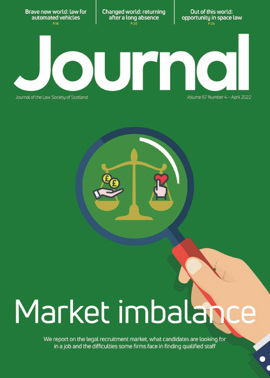A burning issue

Burnout. Once rarely discussed, it’s now recognised by the World Health Organisation as an occupational phenomenon resulting from chronic workplace stress that has not been successfully managed. Common signs include feeling tired or drained most of the time; feeling helpless, alone or defeated; having a cynical/negative outlook; self-doubt; procrastinating; and feeling overwhelmed.
It’s a big workplace problem and one that’s greatly affecting our profession, as reported last autumn by the mental health charity, LawCare. Its Life in the Law study captured data from more than 1,700 professionals in the UK. The study used recognised academic scales for burnout (disengagement and exhaustion), autonomy (ability to control what, where, how, and with whom, work is done), and psychological safety (ability to speak up with ideas and questions, raise concerns or admit mistakes). It found that legal professionals were at high risk of burnout, with those aged between 26 and 35 displaying the highest scores. In the 12 months before the survey, 69% of participants had experienced mental ill health, but only 56% had talked about it at work. The most common reason for not doing so was the fear of stigma and the resulting career, financial and reputational consequences.
Factors in the scales
I’ve been in the legal profession for over two decades, and unfortunately these results don’t surprise me. Life in law is tough! It’s competitive with high expectations, long hours, heavy workloads and tight deadlines. For many of us, working from home when the pandemic hit meant that, more than ever, there was no clear distinction between home life and work, leading to burnout for some. Now, as many workplaces shift to permanent hybrid working models, which bring their own challenges, how do we ensure burnout isn’t one of them? Associated with absenteeism, higher staff turnover, lower productivity and commitment at work as well as a negative impact on physical and mental health, it has a huge effect on both individual and employer.
Organisational factors can play a bigger role in preventing burnout than individual level factors. To decrease the likelihood of burnout, the following things must be high on the agenda in any workplace: job autonomy and security, monitoring workloads, clearly communicating expectations, good manager support, staff engagement, creating a strong set of positive values and sense of belonging, and equality and fairness. A failure to address such key aspects leads to the core of many workplace conflicts, impacting negatively on individuals’ health and wellbeing. While weekly fitness classes, or staff days out, are excellent ideas, they don’t deal adequately with the problems at the heart of matters. Continuous work, investment and leadership on organisational issues is vital so that a positive and supportive culture is created as a preventative measure.
It’s also important to note that, despite the added stress and exhaustion, women senior leaders do more to help their employees navigate work-life challenges, than men at the same level. The McKinsey report, Women in the Workplace 2021, highlighted that women are the ones stepping up to be the leaders that workplaces most need and value. They spend additional time helping manage workloads and are more likely to focus on emotional support and advancing diversity, equity, and inclusion. Burnout among these senior leaders is common because they’re disproportionately doing this additional crucial work in the workplace, often unrecognised and unrewarded, as well as at home.
Things we can all do
Burnout is not an individual issue that can just be managed with self-care. Our profession is at risk of losing talent unless we become proactive and innovative. Whatever our position or level of seniority, we can all contribute towards reducing the core causes. Say “thank you” or give positive feedback when someone does a good job, making them feel valued. Check in on colleagues more often. Train our managers to spot the signs and look for changes in behaviour that may suggest burnout. Are we familiar with our mental health procedures/employee assistance programme, or do we need to put them in place? Issue clear instructions when distributing work so there’s no confusion about who is doing what or when it needs done by. Keep colleagues informed about changes or upcoming projects. Focus on creating environments where individuals feel safe sharing. Have open and real conversations and set clear guidelines and boundaries about excessive working hours.
The Scottish Government has committed to undertaking “meaningful discussions” on providing its employees the “right to disconnect”. I’ll be following these with great interest as, although they are confined to Government employees for now, the current climate regarding workplace burnout lends itself to extending such discussions to other sectors.
There has been much recent progress in addressing mental health stigma in the legal profession. However, burnt out employees often remain hesitant to speak out even when, quite frankly, they are drowning. I know from experience that little things, if done meaningfully and with the correct intention, have a huge impact on empowering those who might be struggling to speak up. It’s important for senior leaders to model a healthy work culture, acting as positive role models.
Our profession’s greatest asset is its people. Let’s create a culture that puts our people first.
Perspectives
Features
Briefings
- Criminal court: Thom bar still applies
- Licensing: tighter rules for the pet trade
- Insolvency: Transition from the COVID measures
- Tax: What did the Spring Statement bring?
- Immigration: Providing a home for Ukrainians
- Scottish Solicitors' Discipline Tribunal
- Property: RCI – what does it involve?
- In-house: Looking for a star







